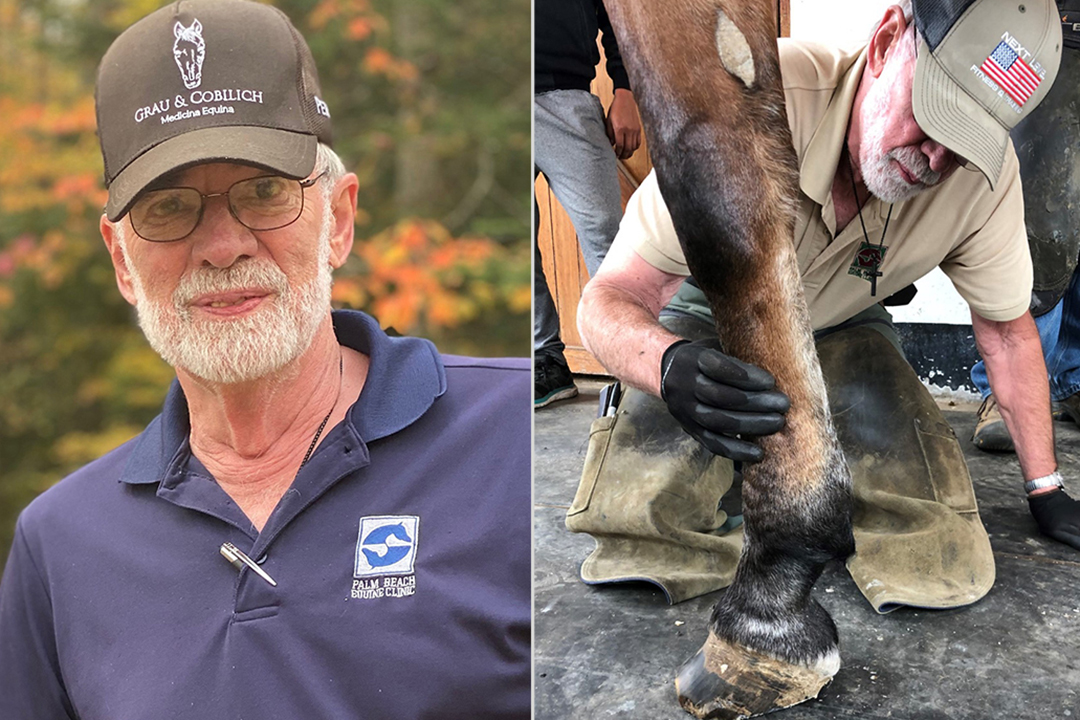
'Helping the horse': combining veterinary medicine and farriery
Dr. Steve O’Grady, who is internationally known for his dual expertise as a farrier and a veterinarian, is the Western College of Veterinary Medicine’s featured “EquineED Talk” speaker at the 2022 Saskatchewan Equine Expo on Friday, Oct. 28.
By Jessica ColbyThe focus of O'Grady's presentation will be on equine foot care as well as the relationship between veterinarians and farriers, which has had its share of ups and downs in the past. As a member of both professions, O’Grady recognizes the benefits of having veterinarians and farriers working together to ensure the overall health and soundness of the horse.
“This has been one of my lifelong projects: to improve this professional relationship,” says O’Grady. “The veterinarian bringing the medical aspect and the farrier bringing the mechanical aspect to the table — both of them working together.”
O’Grady’s early interest in horses led him to a job as a farrier’s apprentice after dropping out of high school in his hometown of West Chester, Pa.
“I was lucky enough to get an apprenticeship with one of the best farriers in the area in Pennsylvania at that time, and I served a three-year apprenticeship,” says O’Grady, whose mentor was Joseph M. Pierce — a member of the International Horseshoeing Hall of Fame.
After practising as a farrier for 10 years, O’Grady decided to act on his dream of becoming a veterinarian. While he worked as a farrier during the day, he attended high school classes at night and eventually obtained his high school diploma through a university program.
“I wanted to be able to, number one, look further into the foot, and number two, be able to one day bring the two professions together,” says O’Grady. “I ended up going to Haverford College which is a very well-known small liberal arts college in Pennsylvania. And that set the stage to apply to veterinary school.”
After finishing vet school at South Africa’s University of Pretoria in 1981, O’Grady went to Charlottesville, Va., and completed an internship at Georgetown Equine Hospital, an equine referral centre. He stayed on as an associate veterinarian at the hospital for another eight years, and since he really liked the state of Virginia, he made it his home.
O’Grady gave his first public lecture at the American Association of Equine Practitioners’ (AAEP) annual symposium in 1999. While he was “scared to death” of public speaking, O’Grady was very familiar with the topics he was talking about: horses’ feet, the relationship between farriers and veterinarians, and the benefits of bringing the two professions together.
O’Grady now holds an AAEP record for speaking over 20 times at the organization’s annual symposium. He’s also lectured in 22 countries — including several visits to Canada.
O’Grady’s goal of combining veterinary and farrier knowledge to better treat a horse’s foot problems began to materialize in 2003 when he opened his first practice, Northern Virginia Equine in Marshall, Va. After working there for just over a decade, O’Grady “semi-retired” to started Virginia Therapeutic Farriery. Located in Keswick, Va., his specialty practice is devoted to equine referrals from veterinarians or farriers.
“We get enough cases from which we can still publish papers,” says O’Grady, who regularly travelled to examine a horse or to lecture somewhere in the world before the COVID-19 pandemic began. While his calendar is starting to include more in-person presentations and diagnostic exams, O’Grady continues to offer Zoom meeting consultations for difficult cases.
When a horse is brought into O’Grady’s practice with a foot problem, he’s adamant about collecting a complete medical history on the equine patient. Then, he and the referring veterinarian or farrier will set out to determine if and where the horse is lame and the severity of its lameness.
“We’ll try to localize that lameness to the horse’s foot and sometimes that involves just using hoof testers, flexions, extensions or other manipulations. Then the use of local anesthesia is injected into areas of the foot to localize [the lameness] to a certain area of the foot … and then imaging is used and whatever else is needed to make a diagnosis,” says O’Grady.
Once the problem with the horse’s foot is diagnosed, the treatment process begins. If the lameness occurs between the pastern and the foot, it’s generally treated with some sort of medication — either an injection or tablets given orally. In most cases, a lameness in the foot will be implicated and caused by an inappropriate foot conformation or a distortion in the horse’s hoof structure.
“In order to further address the joint associated with the foot, you’re going to need to change the conformation of the foot to change the forces acting on the foot so you have a better biomechanical aspect to the joint,” says O’Grady, adding that the combination of medication and farrier treatment go together.
“It’s one of the ways that our farrier referral service plays a big role.”
Therapeutic farriery is a process in which farrier techniques are applied to help change the shape of a horse’s foot or to address a disease process. That could be using a different trim, a different shoe or a combination of a different trim and different shoe, appliance or test.
What’s O’Grady’s favourite part of his job? “Helping the horse,” he says. “The second part of it is teaching. I just think teaching is wonderful. And if I can teach something or demonstrate something that helps a farrier or veterinarian, that in turn helps the horse.”
Click here to register online for Dr. O'Grady's presentation. Registration closes on Friday, Oct. 21.
